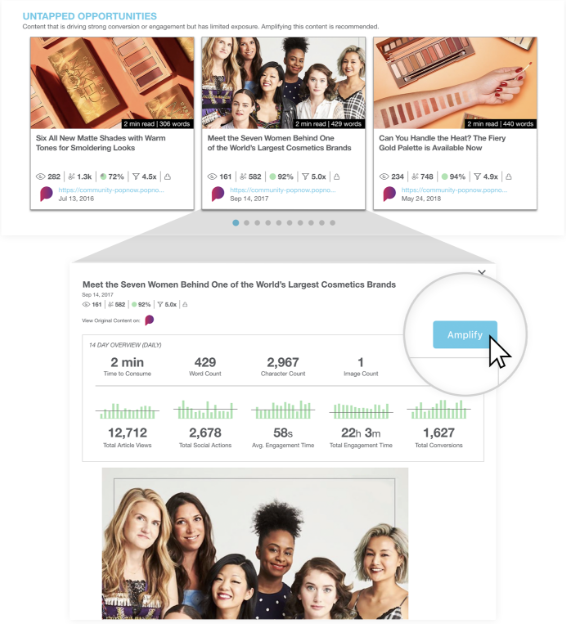How marketers can solve content marketing’s ROI problem

By Justin Choi, CEO, Nativo
When Bill Gates first declared that “content is king” in a 1996 essay, he couldn’t have known just how right he would be. Today’s marketers intuitively and unquestioningly understand that they need content. However, once they create that content, they then have no idea how to measure the return on their investment, much less determine what types, lengths, formats and placements work best.
Over the past two decades, content marketing and digital advertising have ascended hand-in-hand to their positions of marketing supremacy, with the former providing necessary fuel for the latter. Conservative figures by Forrester estimated that U.S. marketers spent more than $10 billion on content marketing in 2016, about half of what was spent on display advertising that year. That $10 billion figure surpassed online video advertising spend (estimated at $9.2 billion by Forrester) and quadrupled U.S. investment in email marketing ($2.6 billion) for 2016. In other words, marketers have been spending a great deal of money on content marketing relative to other categories, yet they’ve been failing to hold this spend to the same expectation of demonstrated ROI.
Despite riding the same societal and technological waves to prominence, content marketing and digital advertising have remained remarkably disconnected in many ways. Digital advertising has remained a defined, concentrated discipline within brand teams, its growth predicated on digital media’s infinite trackability and powerful return on investment. Meanwhile, content marketing represents a diffused, undefined discipline at many brands, a tactic whose responsibility, scope and accountability are poorly understood, if at all. Brands are spending heavily on content creation, but few CMOs today understand exactly where all that creation is happening, how content is being used and, most importantly, whether it’s moving the needle for their brands.
Despite the decentralized and poorly tracked nature of this venture, content marketing investments have remained high due to the indisputable value of the organic traffic driven by search and social media channels, both of which are utterly reliant on content. However, we’re currently witnessing a sea change when it comes to organic reach across all major platforms, one which carries weighty implications for future investment in content marketing.
On the search front, organic reach for brand content on Google has plummeted more than 25 percent on desktop since 2015, and an alarming 55 percent on mobile. These declines are a result of Google’s continued additions of more top-of-page paid search inventory, as well as efforts by the search giant to parse content in a way that users’ questions are answered directly on the search results page — no click-through required. The results of these changes are most striking on mobile pages, where organic brand content results are increasingly being pushed out of view:

Meanwhile, if organic reach is on the decline in search, it’s been declared all but dead on Facebook. Ever since Facebook’s January 2018 algorithm change to prioritize the content of family and friends over that of brands and publishers, getting seen on the social media platform has become a largely pay-to-play endeavor.
So where does that leave the future of content marketing and the $313 billion that brands have been blindly, albeit optimistically, funneling into the creation of presumably valuable assets? With organic reach via search and social media declining rapidly, brands are increasingly uncertain about the ROI on their content investments. John Wanamaker’s now infamous quote on ROI feels newly applicable to the content realm: “Half the money I spend on advertising is wasted; the trouble is I don’t know which half”. Brands know that it’s more than likely that half of their content budgets are being wasted — but they have no idea which half it is. That’s due largely to the fact that they don’t even know where their content investments are going in the first place.
A day of reckoning for content marketing
Content marketing has had its moment in the sun. Now, thanks to massive shifts in search and social media organic reach, it’s past its hype cycle and headed straight for the trough of disillusionment. Does this mean content marketing is going to go away? Not at all. Content is and will remain the lifeblood of a marketing organization. But it’s high time for marketers to rethink where content resides in their organizations, as well as their processes for measuring and optimizing its effectiveness.
CMOs must make several long-overdue shifts to reorient and reconnect content creation within today’s marketing organizations. The future of content marketing will be contingent on marketers being able to answer these three vital questions:
What content do I have?
Brands today, particularly Fortune 500 companies with global footprints, lack a comprehensive view of the content that exists across their websites, blogs and social accounts. How can you understand and optimize assets when you don’t even know they exist?
What content drives business outcomes?
Once a brand has an accurate inventory of content assets, it must go beyond social and sentiment to understand true ROI. Marketers must define their outcomes and be able to attribute conversions right down to individual assets, in real time.
How do we connect content and media efforts to drive a better return?
When brands understand their best-performing assets, they have the ability to amplify that content and boost its discoverability via smart paid media placements.
The above understandings are attainable, but they can require a significant investment in both time and money on behalf of brands. The real challenge is figuring out a way to achieve the above insights without massive additions in personnel, time and effort. At Nativo, we’re striving to help marketers answer the above three questions more easily via ContentQ, our new cloud-based platform that automatically ingests all available brand content no matter where it exists, indexes it and analyzes its effectiveness. The ultimate goal is to arm advertisers with the insights needed to amplify the content’s impact on real-world business outcomes.

We believe that Bill Gates was right about content in 1996 and that he’s right about content in 2018. Content is, and will always be, king. But kings must be accountable to the people they serve. It’s time for marketers to start asking — and answering — the hard questions about their content marketing investments.
More from Digiday

Google delays third-party cookie demise yet again
For now, Google seems to have next year in mind as the latest end date for its plan to eliminate third-party cookies.

Amazon Ads, Reddit and MTV are 2024 Digiday Content Marketing Award finalists
This year’s Digiday Content Marketing Awards finalists focused on creating more relatable, interactive campaigns to improve consumer engagement. These shortlist entries showcase the companies and campaigns successfully using content to modernize media and marketing. With themes spanning social responsibility, personalization, collaborative campaigns with shoppable content and messaging with storytelling and humanization at the core, these […]

Publishers revamp their newsletter offerings to engage audiences amid threat of AI and declining referral traffic
Publishers like Axios, Eater, the Guardian, theSkimm and Snopes are either growing or revamping their newsletter offerings to engage audiences as a wave of generative AI advancements increases the need for original content and referral traffic declines push publishers to find alternative ways to reach readers.





